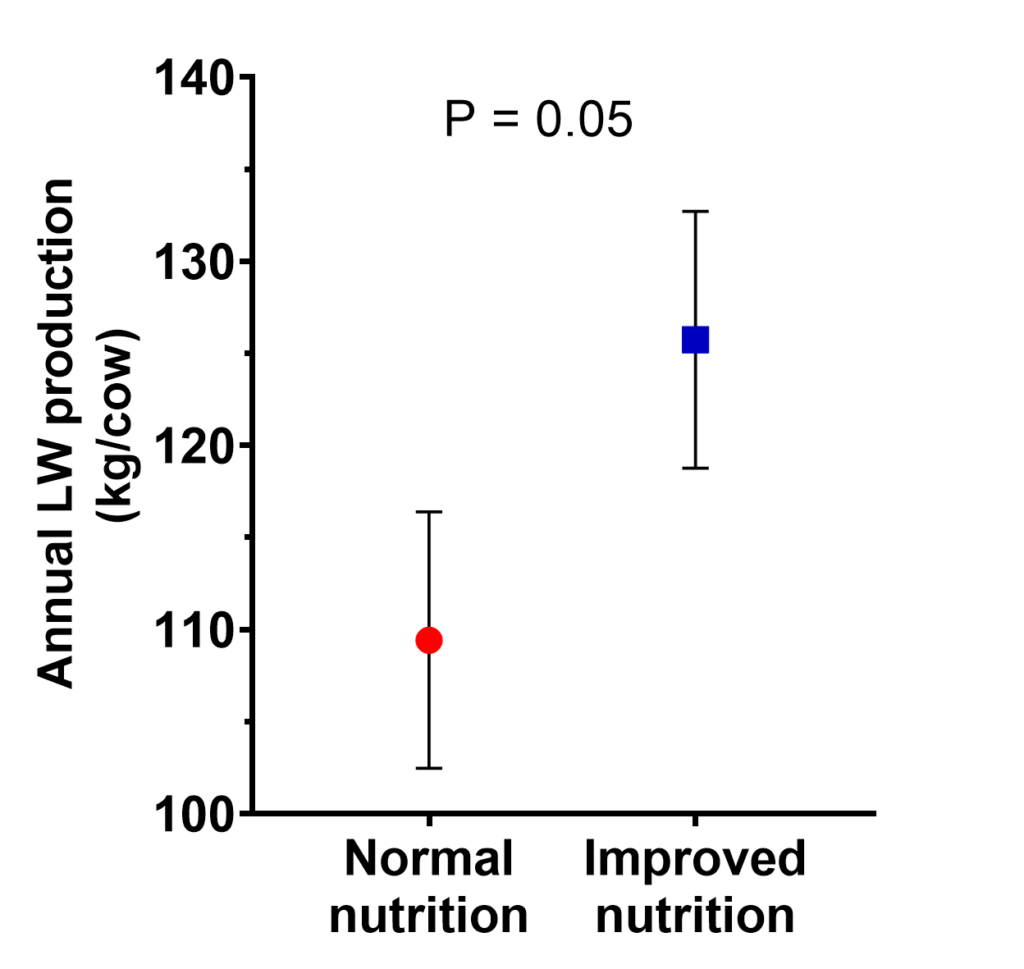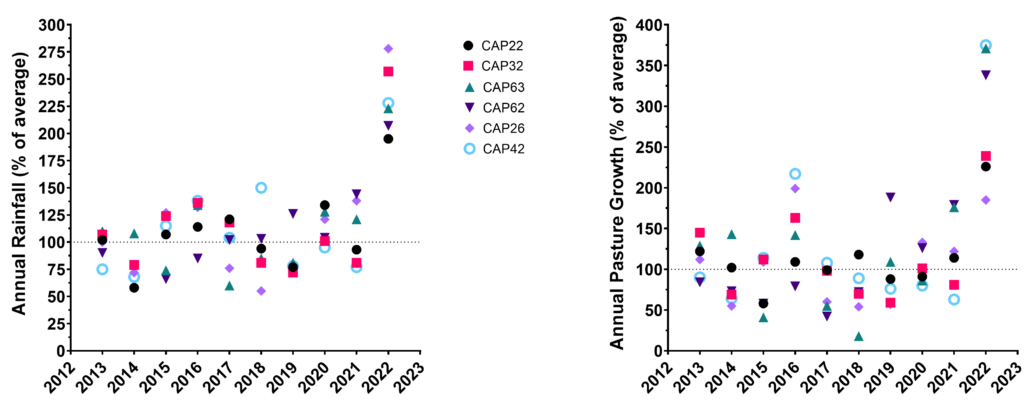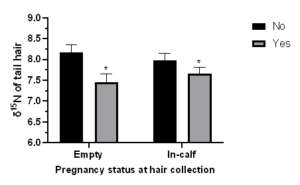2022/2023 Calf Alive Project – Take home messages
Addressing the mortality rate of cows and calves is crucial for ensuring the long-term sustainability of the northern Australian beef industry. The central hypothesis of the Calf Alive project is that poor nutrition and environmental stress are the primary contributors to calf wastage and heifer mortality. This project seeks to explore practical interventions to minimise calf wastage and herd mortality in northern systems. The project team and interested producers recently met in Mt Isa, Qld, to discuss the current results. This summary offers an overview of the trial conducted and results gathered during the first two years of the project.


The Calf Alive meeting in Mt Isa was followed by a field day in Camooweal.
Nutrition as the limiting factor
Research indicates that late-pregnant cows in Northern systems often fall short of their nutritional requirements, specifically in protein intake, with breeders receiving less than 500g/day, compared to the required >1kg/day (CSIRO, 2007). The project aims to address this nutritional deficit by investigating the impact of strategic supplementation during late gestation.
Supplementation approach
Trial animals were randomly assigned to a Control (Ctr) or Treatment (Trt) group, with the latter receiving a tailored supplement mix- an additional 300-400g of protein per head per day. On average, supplements consisted of 40% Crude Protein (CP), 9MJ of ME/kg and 17g’s of Protein (P) per kilogram, offered for an average of ~70 days with an estimated intake of 600g/day (Silva et al. 2022). The supplement was introduced to the herd six weeks before peak calving.
In two production systems where trial animals were co-grazed in the same paddock, a Tru-Test walk-over-weighing system with an auto-drafter (WoW-A) was used to automatically draft trial animals based on their treatment group and RFID. For the remaining sites trial animals were grazed separately in ‘paired paddock’ setup.

WoW-A set up at Rocklands Station, Camooweal
The 2022-2023 results indicated that increasing the nutrition of treatment cows and heifers before calving did not have the expected impact on calf loss (P= 0.3). However, there was a notable increase in pregnancies within four months of calving (P4M) in the Trt group, particularly early in the season. Treatment animals also averaged an improved annual live weight production (LWP) of 16.3kg per cow (Silva et al. 2023).



Figure 1. Improved nutrition did not affect calf loss but increased pregnancies within four months of calving and annual LW production.
In tight-controlled studies, strategic supplementation (14-28 days prepartum) demonstrated positive effects on calf health and growth, as well as improvements in protein and bovine IgG (immunoglobulin) composition in colostrum (Coimbra et al. 2023; Silva et al. 2022). Additionally, it facilitated the necessary decrease in progesterone and an increase in milk delivery (Coimbra et al. 2023; Silva et al. 2022).
Therefore, improving the nutrition of late-pregnant cows can be beneficial in increasing re-conception rates but also in increasing liveweight (LW) and calf health. It is important to note, however, that due to the variability of seasonal changes in the north and the unusually high rainfall and pasture growth in 2022 (Figure 2), supplementation showed no effect, or a negative effect when Crude Protein (CP) exceeded 12% (Silva et al. 2023). Emphasising the importance of considering pasture protein levels when supplementing. It will be interesting to evaluate the response to supplementation in the much drier 2023 season.

Figure 2. Annual rainfall and pasture growth in 2022 were more than 2-fold higher than the average, leading to high pasture quality (above 10% crude protein) during the prepartum period.
Environment as the limiting factor
To assess the variability of minimum rainfall requirements for pasture response in Northern Australia, interpolated daily rainfall records were downloaded from the SILO website (Queensland Government- LongPaddock). The study explores the variability of minimum rainfall requirements for pasture growth in northern Australia, focusing on the northern rainfall onset (NRO) and Green Date (GD) metrics.
NRO is defined by the Australian Bureau of Meteorology as the date when 50mm of accumulated rainfall has occurred after the 1st of September. It represents the theoretical minimum rainfall required to stimulate pasture growth in northern Australia. In central and southern Queensland, green date (GD) is used and defined as the minimum amount of rainfall required after the 1st of September over a set period to stimulate pasture growth. Seasonal forecasts of these events inform management decisions for producers.
This research, based on data from eight properties, spans the years 1942 to 2022. Results show significant variability in NRO and GD across years and locations, with GD having a larger ranger and a lower probability of occurring before mid-Dec (Table 1) (Campbell et al. 2023). While all locations experienced NFO each year, one region did not receive the minimum rainfall for GD in nine out of 80 observed years.
Table 1. Variability of NRO and GD over eight locations in Northern Australia (1942-2022).

The conclusion emphasises the importance of understanding the timing of NFO and GD for effective decision-making in pasture management. It suggests using location-specific definitions based on factors like soil type and pasture composition for more accurate seasonal climate forecasts
Building on this research, Davis Vantage Pro weather stations were installed at each of the ten-collaborating trial sites between late Nov and early Dec 2022 to investigate the relationship between interpolated downloaded from the SILO webpage with that measured on-site. Measured and interpolated data, including rainfall and heat load, were used to calculate the Total Humidity Index (THI).
The study demonstrated strong agreement between measured and interpolated data for both weekly cumulative rainfall and average daily THI, indicating the potential usefulness of interpolated data in approximating environmental factors affecting livestock production (McCosker et al. 2023).

Figure 3. Relationship between weekly total rainfall and calculate average daily THI.
Spotlighting the breeders
To further investigate calf loss, research focused on quantifying the mortality risk associated with age at first calf in commercial beef breeding herds. Early breeding, specifically heifers calving before three years of age, poses an increased risk due to foetal-maternal disproportion causing dystocia and heightened nutritional requirements during pregnancy and lactation.
This pilot study analysed data from a single commercial operation and explored the various data types: Life, Trait, Event, Activity, and Note. The analysis involved mixed models with age and pregnancy as fixed effects and observation year as a random effect. The annual production points revealed that the occurrence of missingness in first-calf heifers was a significant 2.6%. The occurrence of missingness was predicted as 4.3%, 2.3% and 1.6% higher in yearlings (<2-year-old), heifer (2-year-old) or joiners (3-year-old), respectively when compared to non-pregnant females of similar age (McCosker et al. 2023). The statistical analysis showed a significant association between pregnancy, age at first calving and their interaction.
In addition to the trial, a pilot study investigated the impact of previous lactation and pregnancy on tail hair isotopes. Of the 96 cows inducted into the study, 48 were in calf and the remaining 48 were empty. Tail hair isotopes were analysed, confirming lower 15N isotopes in cows with higher reproductive efficiency, indicating less nitrogen loss in the urine (Eyre et al. 2022). This suggests the potential use of tail hair isotopes as a tool for selecting more productive cows likely to produce a calf annually.

Figure 4. Difference in 15N concentrations in tail hair of cattle that have had a calf every year, versus those that have not had a calf every year. * Indicates significant difference P< 0.05
Additional Information
Abstracts submitted to NBRUC 2023
- The impact of prepartum supplementation on the liveweight of cows
- The impact of previous lactation and pregnancy status in tail hair isotopes
- Calf Alive: Quantifying the mortality-risk associated with age at first calf in commercial beef breeding herds
- Calf Alive: Agreement between interpolated and measured weekly rainfall and temperature humidity index (THI)
- Calf Alive: Attendance of study animals at walkoverweigh and autodrafting
- Variability of minimum rainfall requirements for pasture response in northern Australia
This project is funded by Meat and Livestock Australia and supported by the University of Queensland, Queensland Alliance of Agriculture and Food Innovation, Queensland Department of Agriculture and Fisheries, Northern Breeding Business, Northern Territory Government Department of Industry, Tourism and Trade and Feedworks.